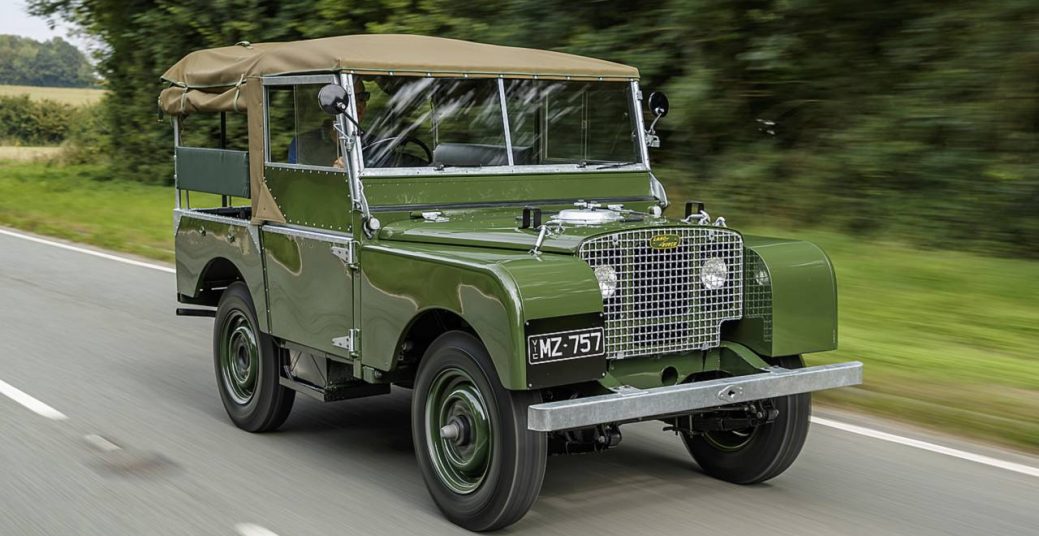Land Rover Series 1

Land Rover Series I (1948 – 1958)
The Land Rover Series I started production in 1948 and was introduced to the world at The Amsterdam Motor Show. It enjoyed a ten-year production run until 1958 when it was succeeded by the Series II. Designed to be a light agricultural and utility vehicle, it quickly evolved to become a ‘multi-purpose’ vehicle used for off-road purposes and as a people carrier.
Concept & Development
Prior to World War 2, Rover was a producer of luxury cars. However, following the war, this type of vehicle was not at all in demand. As a response to this, Rover conceived the Land Rover.
The Land Rover was to be a light agricultural and utility vehicle. Designed by Maurice Wilks, the first ever prototype developed in late 1947 featured a steering wheel that was mounted to the steering wheel; a distinctive feature that became known as the ‘centre steer’. The vehicle was built using a Jeep chassis and utilised the both the engine and transmission from the Rover P3 saloon car.
As developments to the first prototype continued the vehicle evolved. The ‘centre steer’ was scrapped and instead the steering wheel was mounted off to the side. It also received a larger engine and specially designed transfer gearbox.
Land Rover Series I Launch
At launch, the Land Rover Series I was available as one model. This was composed of an 80” wheelbase and featured a 1.6 L petrol engine mated with a four-speed gearbox taken from the Rover P3 and new two-speed transfer box. Like quite a few Rovers of the time, the design incorporated a four-wheel drive system with a freewheel unit.
At its core, the Series 1 was a very basic vehicle. This was illustrated by the fact that tops for the roof and doors were not included as standard but could be added as optional extras in either canvas or metal.
Evolution of the Land Rover
Following the initial launch, it became clear that there was a definite market for a Land Rover with a more developed interior. In response to this, in 1949, a second body option of the Series I was launched which was named ‘Station Wagon’. Featuring a body built by Tickford coachbuilders. This body option featured leather seats, a one-piece laminated windscreen, interior trim, and tin-plate spare wheel cover. While ambitious, the Station Wagon was expensive to build and subject to a higher rate of Purchase Tax, which saw it struggle post-launch.
1952 Model Year
Returning back to the original design, in 1952 a 2.0 L petrol engine was fitted to the Series I and the semi-permanent four-wheel drive system was replaced. During this time, the Land Rover also underwent reclassification, moving from a ‘commercial’ vehicle to a ‘multi-purpose’ vehicle.
1954 Model Year
The 1954 model year saw a slew of major changes, which really started the rapid evolution of the Series I. The 80“ wheelbase was extended to 86” and a new model featuring a 107” wheelbase was introduced. This new iteration of the Series I boasted additional load space and resembled a pickup truck closely in its design.
In this time period the Rover spread bore petrol engine was also added to the Land Rover.
The Station Wagon
In late 1955 the first ever 5-door Land Rover model was introduced. This model had a 107” chassis and could accommodate a maximum of ten people. In a departure from the failed Tickford’s model, this station wagon-like vehicle was simply built with metal panels with the intention for them to be used either as a commercial vehicle or people carrier for the most part.
Station Wagon Land Rovers were set apart from other Series I vehicles in so much as they carried different chassis numbers, special badging and were advertised in separate brochures.
1956 Model Year
In 1956 the wheelbase of the Series I was again extended to 88” and 109” and changes were made to the front chassis cross-member to make way for an all new diesel engine. This new 2.0 L diesel engine made its debut in 1957 and was one of the first high-speed diesels developed for road use.
End of Production
Originally, the Land Rover Series I was intended to be in production for only a few years. As car-production had slowed following the war, the Rover Company were in need of a cash injection and this vehicle was viewed as the means to and end to achieve this. However, following its success the Land Rover became a brand in itself.
Production of the Series I ended in 1958 with the introduction of its successor, the Land Rover Series II.







